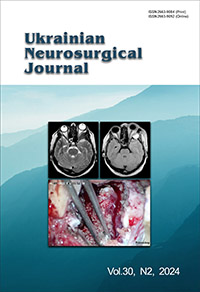The choice of method of electroneuromyogaphy in remote consequences of gunshot and mine-blast injuries of limb nerves
DOI:
https://doi.org/10.25305/unj.299251Keywords:
trauma, gunshot nerve injuries, mine-blast injuries, pain syndrome, diagnosis, electromyography, surgical treatmentAbstract
Objective. Clarification of the nature of damage and degree of functional disorders in the remote consequences of gunshot and mine-blast injuries of limb nerves using neurophysiological techniques (NP) of functional diagnostics (stimulation and needle electromyography), correlation of these data with the nerve damage characteristics determined during surgical interventions (operative findings).
Materials and methods. 480 military personnel and civilians, men aged 18-64 years (average age 33.5 years), with gunshot and mine-blast injuries of limb nerves (LNI) within 1 to 11 months after injury were examined. A total of 1400 EMG studies were conducted. Clinical-neurological methods were used to determine the level, degree, and nature of LNI.
Results. Among the examined 480 patients, complete nerve damage was detected in 299, and partial in 181. Causes of nerve damage included: shrapnel, gunshot, mine-blast injuries, nerve rupture due to bone fractures, injuries by sharp objects, iatrogenic damage. In 62.3% of cases of complete LNI surgical interventions were performed using the technique of neurotization using branches of donor nerves. Provided anatomical integrity of nerve structures and presence of conductivity during EMG testing, external or internal neurolysis was performed. Surgical intervention timing: up to 6 months post-injury - 68.1% of cases; up to 3 months - 31.9%. Based on the results of comprehensive clinical-NP research, adapted schemes for assessing NP data corresponding to each pathohistological type of LNI were developed, and NP criteria for classifying consequences of LNI into three degrees of severity of functional deficit - mild, moderate, and severe were proposed.
Conclusions. Criteria for choosing the optimal NP diagnostic methodology for the remote consequences of gunshot and mine-blast injuries of limb nerves have been determined. Comprehensive clinical-instrumental diagnostics allows to objectify the level and degree of limb nerve damage, signs of neuromuscular apparatus recovery, provides information for planning of the surgical tactics and subsequent rehabilitation therapy.
References
1. Tsymbaliuk VI, Luzan BN, Tsymbaliuk IV. [Diagnostics and treatment of traumatic injuries of peripheral nerves in combat conditions]. Trauma, 2015;16(3):13-18. Ukrainian. http://nbuv.gov.ua/UJRN/Travma_2015_16_3_4
2. Iordache SD, Gorski A, Nahas M, Feintuch L, Rahamimov N, Frenkel Rutenberg T. Treatment of Peripheral Nerve Injuries in Syria’s War Victims: Experience from a Northern Israeli Hospital. Isr Med Assoc J. 2021 May;23(5):279-285. [PubMed]
3. Strafun SS, Borzykh NO, Haiko OG, Borzykh OV, Gayovich VV, Tsymbaliuk YaV. [Priority directions of surgical treatment of patients with damage to the peripheral nerves of the upper limb in polystructural injuries]. TRAUMA. 2021 Nov 5;19(3):75–80. Ukrainian. [CrossRef]
4. Strafun SS, Hayovych VV, Hayovych IV. Likuvannya poshkodzhen’ nerviv kintsivok u rezul’tati vohnepal’nykh poranen’. Herald of orthopedics, traumatology and prosthetics. 2015;(2):16-21. Ukrainian.
5. Tsymbalyuk VI, Petriv TI. Shkaly v neyrokhirurhiyi. Kyiv: Zadruha; 2015. Ukrainian.
6. Gekht BM, Kasatkina LF, Samoylov MI, Sanadze AG. Elektromiografiya v diagnostike nervno-myshechnykh zabolevaniy. Taganrog: Izdatel’stvo Taganrogskogo gosudarstvennogo universiteta; 1997. Russian.
7. Zenkov LR, Ronkin MA. Funktsional’naya diagnostika nervnykh bolezney: rukovodstvo dlya vrachey. Moscow; 2013. Russian.
8. Kasatkina LF, Gil’vanova OV. Elektromiograficheskie metody issledovaniya v diagnostike nervno-myshechnykh zabolevaniy. Igol’chataya elektromiografiya. Moscow: Medika; 2010. Russian.
9. Nikolaev SG. Praktikum po klinicheskoy elektromiografii. Ivanovo: Ivanovskaya gosudarstvennaya meditsinskaya akademiya; 2003. Russian.
10. Chebotaryova LL, Tretyakova AI. Elektrofiziolohichni metody diahnostyky v neyrokhirurhiyi. Kyiv: Fakt; 2017. Ukrainian.
11. Lisaychuk YS. Sovershenstvovanie mikrokhirurgicheskoy tekhniki operatsiy i metodik lecheniya bol’nykh s posledstviyami travm nervov verkhnikh konechnostey [dissertatsiya]. Kiev, 1988. Russian.
12. Siqueira MG, Martins RS. Surgical treatment of adult traumatic brachial plexus injuries: an overview. Arq Neuropsiquiatr. 2011 Jun;69(3):528-35. [CrossRef] [PubMed]
13. Midha R. Nerve transfers for severe brachial plexus injuries: a review. Neurosurg Focus. 2004 May 15;16(5):E5. [CrossRef] [PubMed]
14. Tretyak IB, Gatskiy AA, Kovalenko IV, Bazik AN. To graft or not to graft? Median to radial nerve transfer in the forearm: an alternative approach to treat proximal radial nerve injuries. Ukrainian Neurosurgical Journal. 2018 Sep 28;0(3):34–40. [CrossRef]
15. Nikitin SS, Murtazina AF, Druzhinin DS. [Conduction block as an elec-trophysiological phenomenon: a review of the literature]. Neuromuscular Diseases. 2019;9(1):12–23. Russian. [CrossRef]
16. Pripotnev S, Bucelli RC, Patterson JMM, Yee A, Pet MA, Mackinnon S. Interpreting Electrodiagnostic Studies for the Management of Nerve Injury. J Hand Surg Am. 2022 Sep;47(9):881-889. [CrossRef] [PubMed]
Downloads
Published
How to Cite
Issue
Section
License
Copyright (c) 2024 Oleksandr S. Solonovych, Albina I. Tretyakova, Ihor B. Tretyak, Lidiya L. Chebotaryova, Oleksandr O. Gatskyi, Oksana I. Mytsak

This work is licensed under a Creative Commons Attribution 4.0 International License.
Ukrainian Neurosurgical Journal abides by the CREATIVE COMMONS copyright rights and permissions for open access journals.
Authors, who are published in this Journal, agree to the following conditions:
1. The authors reserve the right to authorship of the work and pass the first publication right of this work to the Journal under the terms of Creative Commons Attribution License, which allows others to freely distribute the published research with the obligatory reference to the authors of the original work and the first publication of the work in this Journal.
2. The authors have the right to conclude separate supplement agreements that relate to non-exclusive work distribution in the form of which it has been published by the Journal (for example, to upload the work to the online storage of the Journal or publish it as part of a monograph), provided that the reference to the first publication of the work in this Journal is included.









